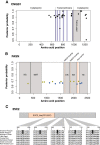Two Antarctic penguin genomes reveal insights into their evolutionary history and molecular changes related to the Antarctic environment
- PMID: 25671092
- PMCID: PMC4322438
- DOI: 10.1186/2047-217X-3-27
Two Antarctic penguin genomes reveal insights into their evolutionary history and molecular changes related to the Antarctic environment
Abstract
Background: Penguins are flightless aquatic birds widely distributed in the Southern Hemisphere. The distinctive morphological and physiological features of penguins allow them to live an aquatic life, and some of them have successfully adapted to the hostile environments in Antarctica. To study the phylogenetic and population history of penguins and the molecular basis of their adaptations to Antarctica, we sequenced the genomes of the two Antarctic dwelling penguin species, the Adélie penguin [Pygoscelis adeliae] and emperor penguin [Aptenodytes forsteri].
Results: Phylogenetic dating suggests that early penguins arose ~60 million years ago, coinciding with a period of global warming. Analysis of effective population sizes reveals that the two penguin species experienced population expansions from ~1 million years ago to ~100 thousand years ago, but responded differently to the climatic cooling of the last glacial period. Comparative genomic analyses with other available avian genomes identified molecular changes in genes related to epidermal structure, phototransduction, lipid metabolism, and forelimb morphology.
Conclusions: Our sequencing and initial analyses of the first two penguin genomes provide insights into the timing of penguin origin, fluctuations in effective population sizes of the two penguin species over the past 10 million years, and the potential associations between these biological patterns and global climate change. The molecular changes compared with other avian genomes reflect both shared and diverse adaptations of the two penguin species to the Antarctic environment.
Keywords: Adaptation; Antarctica; Avian genomics; Evolution; Penguins.
Figures



References
-
- Gill F, Donsker D. IOC World Bird List (v 4.1) 2014.
-
- Ksepka DT, Ando T. Penguins past, present, and future: trends in the evolution of the Sphenisciformes. In: Dyke G, Kaiser G, editors. Living Dinosaurs. Oxford: Wiley; 2011. pp. 155–186.
-
- Watson M. Report on the Anatomy of the Spheniscidae Collected by HMS Challenger, During the Years 1873–1876. Edinburgh: Neill and Company; 1883.
-
- Taylor JRE. Thermal insulation of the down and feathers of pygoscelid penguin chicks and the unique properties of penguin feathers. Auk. 1986;103:160–168.
-
- Sivak JG. The role of a flat cornea in the amphibious behaviour of the blackfoot penguin (Spheniscus demersus) Can J Zool. 1976;54:1341–1345. doi: 10.1139/z76-151. - DOI
Grants and funding
LinkOut - more resources
Full Text Sources
Other Literature Sources
Miscellaneous

